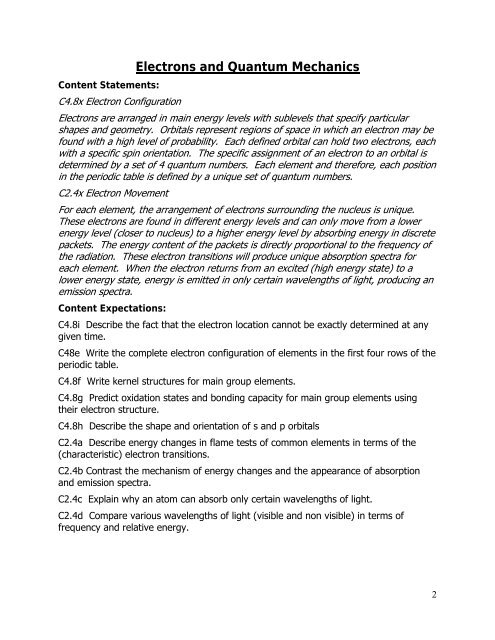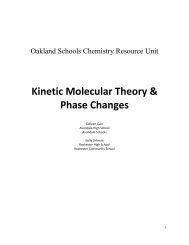Electrons and Quantum Mechanics - Oakland Schools
Electrons and Quantum Mechanics - Oakland Schools
Electrons and Quantum Mechanics - Oakland Schools
You also want an ePaper? Increase the reach of your titles
YUMPU automatically turns print PDFs into web optimized ePapers that Google loves.
Content Statements:<br />
C4.8x Electron Configuration<br />
<strong>Electrons</strong> <strong>and</strong> <strong>Quantum</strong> <strong>Mechanics</strong><br />
<strong>Electrons</strong> are arranged in main energy levels with sublevels that specify particular<br />
shapes <strong>and</strong> geometry. Orbitals represent regions of space in which an electron may be<br />
found with a high level of probability. Each defined orbital can hold two electrons, each<br />
with a specific spin orientation. The specific assignment of an electron to an orbital is<br />
determined by a set of 4 quantum numbers. Each element <strong>and</strong> therefore, each position<br />
in the periodic table is defined by a unique set of quantum numbers.<br />
C2.4x Electron Movement<br />
For each element, the arrangement of electrons surrounding the nucleus is unique.<br />
These electrons are found in different energy levels <strong>and</strong> can only move from a lower<br />
energy level (closer to nucleus) to a higher energy level by absorbing energy in discrete<br />
packets. The energy content of the packets is directly proportional to the frequency of<br />
the radiation. These electron transitions will produce unique absorption spectra for<br />
each element. When the electron returns from an excited (high energy state) to a<br />
lower energy state, energy is emitted in only certain wavelengths of light, producing an<br />
emission spectra.<br />
Content Expectations:<br />
C4.8i Describe the fact that the electron location cannot be exactly determined at any<br />
given time.<br />
C48e Write the complete electron configuration of elements in the first four rows of the<br />
periodic table.<br />
C4.8f Write kernel structures for main group elements.<br />
C4.8g Predict oxidation states <strong>and</strong> bonding capacity for main group elements using<br />
their electron structure.<br />
C4.8h Describe the shape <strong>and</strong> orientation of s <strong>and</strong> p orbitals<br />
C2.4a Describe energy changes in flame tests of common elements in terms of the<br />
(characteristic) electron transitions.<br />
C2.4b Contrast the mechanism of energy changes <strong>and</strong> the appearance of absorption<br />
<strong>and</strong> emission spectra.<br />
C2.4c Explain why an atom can absorb only certain wavelengths of light.<br />
C2.4d Compare various wavelengths of light (visible <strong>and</strong> non visible) in terms of<br />
frequency <strong>and</strong> relative energy.<br />
2
















